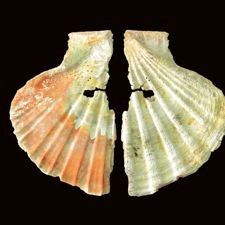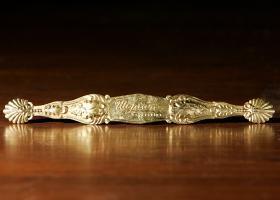Michelle Moran's Blog, page 110
January 9, 2010
Heavy Brows, High Art?: Newly Unearthed Painted Shells Show Neandertals Were Homo sapiens's Mental Equals
By Charles Q. Choi S
S
HELL GAME: The two sides of a perforated upper half-valve of Pecten maximus from Middle Paleolithic level I-k of Cueva Anton (height: 120 mm). The external side (right, in the picture) was painted with an orange mix of goethite and hematite, either to regain the original appearance or to make it the same color as the internal side, which remained its natural red Joao Zilhao
Newly discovered painted scallops and cockleshells in Spain are the first hard...
January 8, 2010
Egyptian Eyeliner May Have Warded Off Disease
By Katie Cottingham
ScienceNOW Daily News
Read the rest on Science Now.
Massive statue of Pharaoh Taharqa discovered deep in Sudan
By Owen Jarus
[image error]Berber-Abidiya Archaeological Project:
The largest piece of the Taharqa statue is pictured here. It includes parts of the base and torso. There is an inscription on the back-pillar.
No statue of a pharaoh has ever been found further south of Egypt than this one. At the height of his reign, King Taharqa controlled an empire stretching from Sudan to the Levant.
Read the rest on the Independent UK.Did Unemployed Minoan Artists Land Jobs in Ancient Egypt?
Read the rest here.
Did We Mate Or Murder Neanderthals?
Read the rest on CBS news.
January 7, 2010
Most ancient Hebrew biblical inscription deciphered
Prof. Gershon Galil of the University of Haifa who deciphered the inscription: "It indicates that the Kingdom of Israel already existed in the 10th century BCE and that at least some of the biblical texts were written hundreds of years before the dates presented in current research."
Read the rest on Eurekalert.First Minoan Shipwreck
Crete has seduced archaeologists for more than a century, luring them to its rocky shores with fantastic tales of legendary kings, cunning deities, and mythical creatures. The largest of the Greek islands, Crete was the land of the Minoans (3100-1050 B.C.), a Bronze Age civilization named after its first ruler, King Minos, the "master of the seas" who is said to have rid the waters of pirates.
Scientists discover oldest footprints on Earth
(CNN) -- Scientists have found the oldest fossilized footprints made by a four-legged creature forcing a rethink on when fish first crawled out of water and onto land.
January 6, 2010
What Happened to the Hominids Who May Have Been Smarter Than Us?
The following text is an excerpt from the book Big Brain by Gary Lynch and Richard Granger, and it represents their own theory about the Boskops. The theory is a controversial one; see, for instance, paleoanthropologist John Hawks' much different take.
In the autumn of 1913, two farmers were arguing about hominid skull fragments they had uncovered while digging a drainage ditch. The location was Boskop, a small town about 200 miles inland from the east coast of South Africa.
A sweet discovery: Evidence reveals chocolate enjoyed in St. Augustine in the 1500s
 The Utopian Chocolates solid gold box decoration from the late 1800s was found near Orange and Cordova streets. By DARON DEAN
The Utopian Chocolates solid gold box decoration from the late 1800s was found near Orange and Cordova streets. By DARON DEANBy Marcia Lane
In a plastic container inside the storerooms at St. Augustine's Government House is a slender wooden stick with a carved knob on one end. Think of it as an electric mixer without the electricity.



